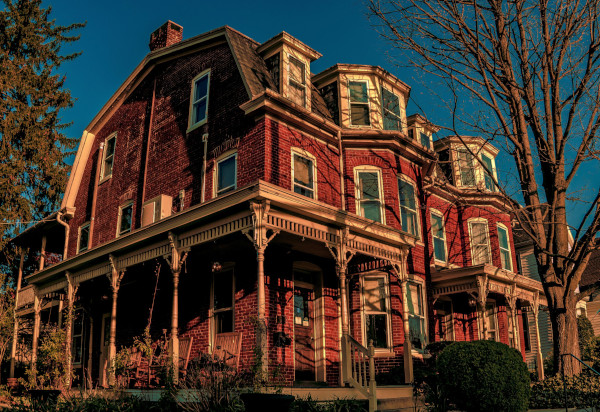The Brooklyn Ghost
At one point in America, newspapers from all over the nation published stories about people’s eerie experiences with ghosts. In the late 1800s and early 1900s, many of these reports were published by The New York Times, with one of them being the tale of the Brooklyn Ghost.
This creepy account was experienced and told by Edward F. Smith, his wife, and his two daughters. The holiday horror story detailed the strange activity they experienced around Christmas at their home on Clinton Avenue in Brooklyn, New York — a beautiful Greek Revival home that still stands today.
Venture with US Ghost Adventures as we follow in the footsteps of the Smith family and relive the heart-pounding frights that made headlines all those years ago.
To explore this historic city, book a tour with New York Ghosts!
A Haunting Beginning
The terror began just before Christmas when the Smith’s doorbell would ring for three weeks leading up to the holiday between 5 p.m. and midnight. When Smith answered the door for the first time, no one was there. This would continue for hours into the night, like a strange game of ghost-and-mouse.
The Times told:
‘Their quiet life was seriously disturbed three weeks ago, when one night Mr. Smith went to the door three or four times in response to the ringing of the bell, and every time was surprised to find no one there.’
After the doorbell stopped its incessant sound, a loud banging could be heard from the home’s two back doors. The rattling was so intense that it sounded as if the doors would fly from their hinges.
Concerned that the disturbance had become a nightly occurrence, Smith enlisted the help of his family and friends to determine the cause. Even with a handful of people stationed in and around the home, no one could pinpoint the cause.
Smith even went as far as to sprinkle ashes on the paths that led to his doors, but no footprints ever appeared.
The Hunt for the Brooklyn Ghost
When the family began to lose sleep, and the phantom ding-dong-ditcher wasn’t showing any signs of letting up, the Smith family persuaded the police to investigate.
A captain and a detective visited the home, but they, too, could not determine what was going on. On one of the nights that law enforcement was at the home, a brick flew in through the dining room window. The officers swore no one was outside when the brick came crashing into the home.
The police searched the home for hidden wires, suspecting a hoax, but their search was in vain.
At first, Smith stated that he was skeptical that the strange happenings were otherworldly,’ but he soon became convinced that ghosts must be behind the unexplained activity.
By this point, 136 Clinton Avenue had become an attraction and was inundated with people hoping to catch a glimpse of the activity. Folks were begging for access to the home for seances and investigations. Smith wasn’t having any of it; he did not want to allow strangers into his home and stated that ‘we consider ourselves perfectly able to take care of any ghost that comes along.’
However, that did not deter visitors. Some went as far as to conduct ‘semi-seances’ from the home’s sidewalk. Police even had to disperse the crowds periodically, and at one point, an officer was bitten on the fingers by ‘one powerful German who refused to move.’
So, what caused the haunting? One explanation suggested by locals was that a lawyer had allegedly committed suicide in the home. It was believed the beleaguered spirit remained trapped in the home where he took his last breath.
In a follow-up article on December 21st, 1878, The New York Times stated that Smith had finally solved his problem. It was determined that the devil himself was causing the commotion. When he prayed over his home, the activity stopped altogether.
The police were not prepared to accept the devil hypothesis. Still, they were ‘ready to swear that they have heard and seen the startling demonstrations, and they are morally certain that it is beyond all human probability that any earthly hands pulled the bell, pounded on the doors, or threw the brick through the dining room window.’
'Knew He Was Becoming Insane'
In a further dig for information, this small news article appeared in an issue of the Times from February 21st, 1881:
‘While Officer Hulton was patrolling his post on Montgomery Street, Jersey City, yesterday morning, a man accosted him and asked to be taken into custody, saying that he felt an attack of insanity coming to him. The officer took the man to the First Precinct Station house, where he described himself as Edward F. Smith, Captain of the Schooner George H. Bent, now lying at Hunter’s point. Shortly after he arrived at the Station House, Smith’s insanity developed itself, and he was confined in a room, and the County Physician was summoned. Last evening, he seemed to have grown better and talked quite sensibly.’
Could this man have been the same Edward F. Smith who endured Clinton Avenue’s hauntings?
The Home Today
The beautiful pillared home at 136 Clinton Avenue is known today as the Lefferts-Laidlaw House and is sadly the only landmarked building in the Wallabout neighborhood. The home was added to the National Register of Historic Places on September 12, 1985, preserving it and whatever dwells within its tainted walls.
Renovations have since been done to the home, and the home was sold to a private New York fashion designer in 2019. Stay tuned, as we’re anxiously awaiting more stories from the haunted home on Clinton Avenue.
Continue with “25 Days of Christmas” and US Ghost Adventures to learn more about the spirits that walk among us on Christmas!
Sources:
https://en.wikipedia.org/wiki/Lefferts-Laidlaw_House
https://seeksghosts.blogspot.com/2019/06/the-brookyn-ghost.html




